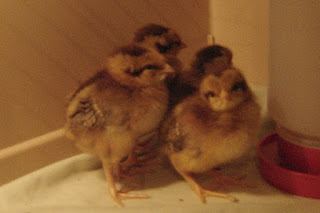March Madness is not simply for basketball. Around here, we have March Chick Madness. We try to start our flock rotation in March. We did not do this last spring, and although it's not that bad, what we seriously missed was the new flock's transition as egg layers while the older flocks are moulting. This year, will be different again in that we will be transitioning in the new layers while also trying to raise a few meat chickens during the summer months. The meat chicks will arrive the middle of April.
We picked up four Welsummer chicks (pullets) yesterday and they are adapting. It's always such a strange shift. The first few days (usually about 5 days), the chicks seem too small for the brooder, which is, essentially, a small animal cage with high sides. But by the end of the week, they will be all over the floor space, starting to flap their wings, and by the end of the second week, they will be too big for our brooder cage. We have a larger, alternate brooder space ready to move them out to the garage by that time. After a month, they will be almost ready to go outside! We will have our next batch of chickens and will be starting all over. So this year, we will have 10 chicks in total for the spring fling.
It's hard getting good photos with the subdued lighting with speedy little balls of fluff. This is the best I could do, today. These gals hatched approximately March 12th or 13th. We know that they are females because of the black markings on the sides of their heads, behind their eyes. Whee!
Some people ask us why we don't use straw or wood flakes in the brooder. We find that the new chicks' legs and feeding habits get a better start on a firm, non-slippery surface. So we have cut-up an old sheet into sections that we change out every day during the first week. Then, by the second week, we usually transition in some aspen shavings along with a sprinkling of diatomaceous earth (DE) because the aspen has less odor than the pine (never use cedar). The DE helps to cut down on loose stools and helps to reduce the lice situation that sometimes shows up about this time. We always use food grade DE. And by week three, the chick fecal smell is so bad, that it's time to move them out into the garage! I hand wash the little sheets in a mild bleach solution; letting them air dry so that there is not a chemical smell for the next use.
Some people ask us why we don't use straw or wood flakes in the brooder. We find that the new chicks' legs and feeding habits get a better start on a firm, non-slippery surface. So we have cut-up an old sheet into sections that we change out every day during the first week. Then, by the second week, we usually transition in some aspen shavings along with a sprinkling of diatomaceous earth (DE) because the aspen has less odor than the pine (never use cedar). The DE helps to cut down on loose stools and helps to reduce the lice situation that sometimes shows up about this time. We always use food grade DE. And by week three, the chick fecal smell is so bad, that it's time to move them out into the garage! I hand wash the little sheets in a mild bleach solution; letting them air dry so that there is not a chemical smell for the next use.

